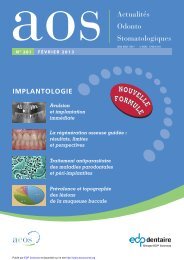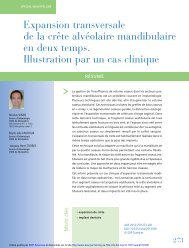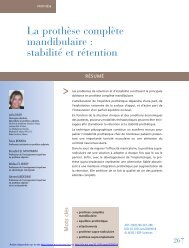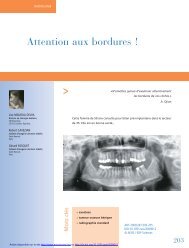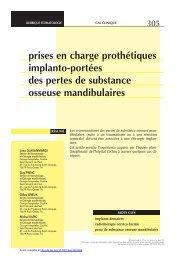PDF (850.3 KB) - Actualités Odonto-Stomatologiques
PDF (850.3 KB) - Actualités Odonto-Stomatologiques
PDF (850.3 KB) - Actualités Odonto-Stomatologiques
Create successful ePaper yourself
Turn your PDF publications into a flip-book with our unique Google optimized e-Paper software.
PROTHÈSE C. Vacher, M.-F. Vecchierini, D. Léger, J.-P. Laaban, G. Putterman, M. Figueredo, P.-J. Monteyrol, P. Philip, J. Lévy<br />
24. Bruno Carlo B, Mauro P,<br />
Silvia B, Enrico S.<br />
Modified genioplasty<br />
and bimaxillary<br />
advancement<br />
for treating obstructive<br />
sleep apnea syndrome.<br />
SUMMARY<br />
162 <strong>Actualités</strong> <strong>Odonto</strong>-<strong>Stomatologiques</strong> - n° 250 - juin 2010<br />
J Oral Maxillofac Surg<br />
2008;66:1971-4.<br />
25. Maganzini AL,<br />
Alhussain IY.<br />
Treatment<br />
of obstructive sleep apnea<br />
with combined<br />
orthognatic-orthodontic<br />
approach assessed<br />
by nocturnal<br />
polysomnography.<br />
NY State Dent J<br />
2008;74:36-40.<br />
Study about a traction-based mandibular<br />
repositioning device for treatment<br />
of obstructive sleep apnea syndrome<br />
Christian VACHER,<br />
Marie-Françoise VECCHIERINI,<br />
Damien LÉGER,<br />
Jean-Pierre LAABAN,<br />
Gil PUTTERMAN,<br />
Micheline FIGUEREDO,<br />
Pierre-Jean MONTEYROL,<br />
Pierre PHILIP,<br />
Joël LÉVY<br />
Keywords<br />
● obstructive sleep apnea<br />
● quality of life<br />
● treatment<br />
Introduction<br />
The aim of this study was to assess efficacy and compliance of a tractionbased<br />
mandibular repositioning device (O.R.M. type device) for treatment of<br />
moderate to severe obstructive sleep apnea syndrome (OSAS) under patient<br />
driven protocol in routine outpatient care setting.<br />
Material and methods<br />
40 patients, 10 severe and 30 moderate OSAS sufferers (Apnea hypopnoea<br />
index [AHI] > 30 and > 15, respectively), were enrolled by four sleep centres.<br />
Nocturnal polygraphy, quality of life, and quality of sleep interviews were<br />
used to evaluate the results of treatment after 45 days.<br />
Results<br />
35 patients completed the study. Frequency of respiratory events, daytime<br />
sleepiness, snoring, patient assessment of sleep quality, specific SF-36 quality<br />
of life items and Pittsburgh Sleep Quality Index improved significantly with<br />
the MRD. 60% of patients were «responders» (> 50% decrease in AHI).<br />
Observance of treatment was high; 80% of patients wore their MRD every<br />
night. The adverse events were minors and rare.<br />
Discussion<br />
Efficacy on respiratory and somnolence parameters of this innovative traction-based<br />
MRD was validated under a simple protocol of care with response<br />
rate similar to those published in the literature. This study shows consistent<br />
significant improvement by the MRD on quality of life and quality of sleep<br />
parameters across several tests. Treatment with the MRD under a simple,<br />
patient-driven protocol of care with control nocturnal polygraphy is appropriate<br />
for routine outpatient practice especially for moderate OSAS patients.




